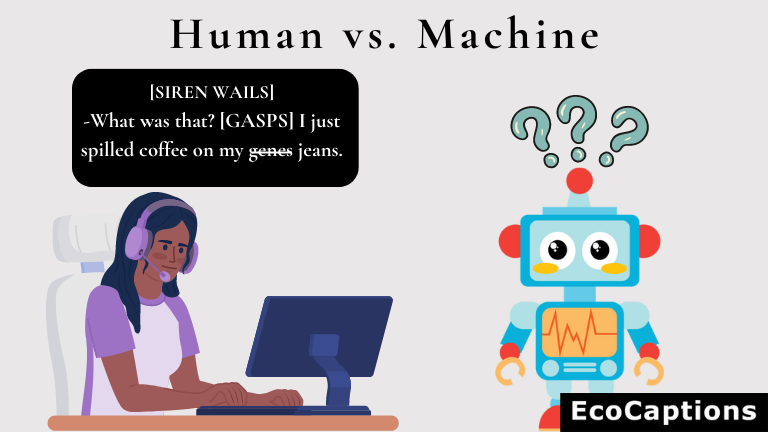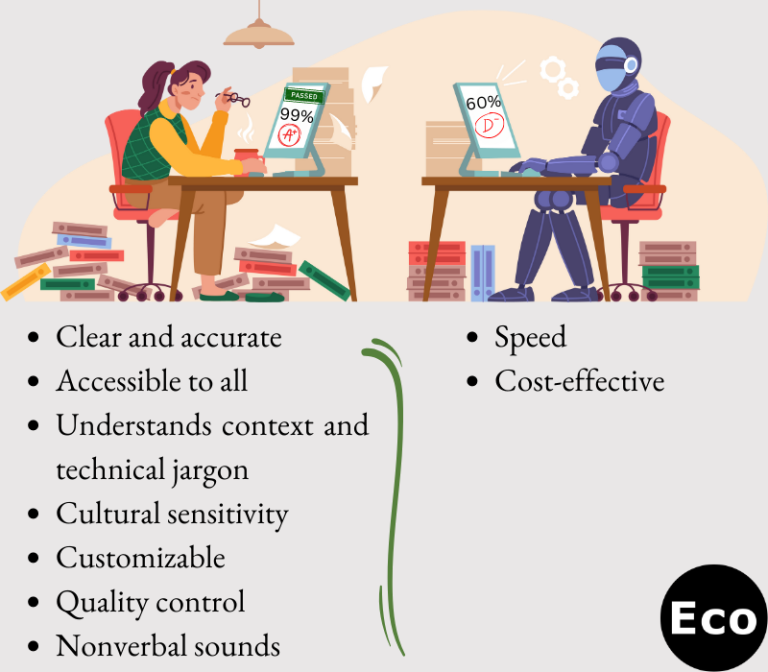
In today's digital age, captions have become an essential part of our online experience. They are used on social media, video sharing platforms, and in various other contexts to make content accessible to a wider audience. While there are various options available for generating captions, the debate over whether human-edited captions are better than AI-generated captions continues. In this article, we will explore why human-edited captions are superior to AI-generated captions.
Accuracy and Clarity
One of the most significant advantages of human-edited captions is their accuracy and clarity.
Humans have the ability to understand the context, tone, and nuances of a language that are often missed by AI algorithms. Human editors can identify and correct errors and grammar mistakes, distinguish between homophones, and ensure that the captions are accurate and easy to understand.
On the other hand, AI-generated captions can often be inaccurate, especially when it comes to identifying the correct words or phrases in the audio or video. It is estimated that YouTube captions, for example, are only about 60-70% accurate!
Where real people can really excel is when dealing with files that contain a lot of technical jargon, which is often highly specific to a certain field--think, for example, complicated medical, scientific, and programming terms. Whereas AI can often completely botch those terms, human editors are able to take context clues and do research to find the correct spelling.

AI algorithms rely on speech recognition technology, which is not always accurate, particularly in cases where the audio quality is poor or the speaker has an accent. This can lead to misinterpretations and mistakes in the captions, which can make it frustrating for viewers trying to understand the content.
AI-generated captions also often struggle with punctuation, whereas human editors have a better understanding of grammar and punctuation rules, enabling them to provide properly structured captions free from errors.
Context and Cultural Sensitivity
While AI-generated captions have come a long way in recent years, they still struggle with capturing the subtleties of language and culture that human editors are able to detect.
Human editors are able to draw on their knowledge of cultural norms, traditions, and history to provide context and understanding for viewers. This can be especially important when dealing with content that contains references or allusions that may be unfamiliar or confusing to non-native speakers.
Captions that are not culturally sensitive or contextually accurate can be offensive or misleading. For example, AI-generated captions may not be able to identify colloquial expressions, idioms, or cultural references, which can lead to misunderstandings. I can't even tell you the amount of times I've seen auto-generated gibberish and obscenities in the place of a foreign language!
Human editors, on the other hand, can take into account the cultural context and ensure that the captions are sensitive and accurate. This is particularly important in cases where the content is targeted at a specific audience, or where the content may have cultural implications.
Additionally, when it comes to accents, human editors are able to recognize and differentiate between different regional or cultural variations in pronunciation, intonation, and other linguistic features. This allows them to create more accurate and nuanced captions that reflect the diversity and complexity of spoken language.
Accessibility
Human-edited captions can improve accessibility by capturing nonverbal sounds that are important for understanding the context and emotional tone of the content. Nonverbal sounds include things like laughter, applause, sighs, and gasps, as well as background noises like music, ambient noise, and other environmental sounds.

Capturing nonverbal sounds in captions is particularly important for individuals who are deaf or hard of hearing as they may not be able to hear these sounds and may miss important elements of the content. By deciphering which nonverbal sounds are important to the context of the video, human editors can provide a more complete and accurate representation of the content, which can help to improve accessibility and enhance the overall viewing experience.
For example, if a video features a comedy sketch, the audience's laughter is an important element of the content, as it conveys the humor and emotional tone of the scene. If these sounds are not captured in the captions, viewers who are deaf or hard of hearing may not be able to fully understand or appreciate the humor of the scene. By including the sound of laughter in the captions, human editors can provide a more complete and accurate representation of the content, which can help to make the content more accessible and enjoyable for all viewers.
Similarly, in a music performance, capturing the sound of the instruments and the singing can provide important context and emotional tone for viewers with hearing impairments, who may not be able to fully appreciate the performance without this information.
In addition to capturing nonverbal sounds, human-edited captions can also provide important contextual information that is not conveyed through the audio alone. This can include information about the speakers, their tone of voice, and the overall emotional tone of the content. By including this information in the captions, human editors can help to make the content more accessible and inclusive, which can benefit a wide range of viewers, including those who are deaf or hard of hearing, non-native speakers of the language being used, or those who may have difficulty following the audio for other reasons.
Overall, capturing nonverbal sounds in captions can greatly improve the accessibility of content for viewers with hearing impairments and can also enhance the viewing experience for all viewers by providing additional context and emotional tone. Human editors are able to provide this level of detail and nuance that AI-generated captions are not yet able to match, making them an important component of ensuring accessibility for all viewers.
Customization
Another advantage of human-edited captions is the ability to personalize the captions to meet the specific needs of the audience. Captions that are edited by humans can be tailored to suit the specific language needs, literacy levels, or accessibility requirements of the audience. This is particularly important for viewers who have hearing impairments, who may require captions to follow the flow of the conversation, or who may require captions that include descriptions of sounds and other auditory cues.
At EcoCaptions, for example, we provide you with various caption formats depending on your needs (True Verbatim, Eco Verbatim, and Clean Verbatim), speaker ID formats, caption speeds, number of words per line, et cetera. Additionally, when submitting an order, you are also able to add special instructions for your files, which we do our absolute best to meet.
While AI-generated captions can provide a general level of accessibility, they are often not customizable to meet the specific needs of the audience. This can limit the effectiveness of the captions in reaching a wider audience.
Quality Control
Finally, human-edited captions provide a level of quality control that is often lacking in AI-generated captions. People are able to review the captions, identify errors, and correct them before they are published. This ensures that the captions are accurate, contextually appropriate, and easy to understand. This can be especially important when it comes to sensitive content where accuracy is essential.
At EcoCaptions, every single file is thoroughly reviewed after the editing process to ensure the highest possible quality and accuracy. In contrast, AI-generated captions are often produced automatically, without any quality control or review process. This can lead to errors and inaccuracies that can make the captions difficult to understand, or even offensive.
By using house style guides as well as standard style guides (here, we use the Chicago Manual of Style), human editors also have the ability to ensure that the captions meet specific quality standards, such as captioning guidelines and standards for accessibility, as well as ensuring consistency in terminology, spelling, and other linguistic features across multiple captions, which can be important for maintaining a consistent tone and style.
Conclusion
Human-edited captions are preferable to AI-generated captions in terms of accuracy, clarity, cultural sensitivity, transcription of nonverbal sounds, personalization, and quality control. While AI-generated captions may be faster and more cost-effective, they often lack the nuance, accuracy, and context that human editors can provide. As the need for accessibility and inclusion in digital media continues to grow, it is important to prioritize the use of human-edited captions in order to ensure that all viewers have access to content that is accurate, engaging, and easy to understand.

Furthermore, the use of human-edited captions can also provide economic and social benefits. By hiring human editors, companies and organizations can support the creation of job opportunities for individuals with language and writing skills, particularly in countries with high unemployment rates or limited job opportunities. Additionally, human-edited captions can be a way to support the growth of the creative industry, as it provides opportunities for writers, editors, and translators to apply their skills in a meaningful and impactful way.
While AI technology has its place in certain areas, it is important to recognize the value and importance of human expertise when it comes to creating accurate and engaging captions. As we continue to navigate the evolving digital landscape, we must prioritize the use of human-edited captions to ensure that content is accessible to all and that we are creating economic opportunities for individuals and communities around the world.
Experience the difference of human-edited captions, and make your content accessible to all with EcoCaptions!
